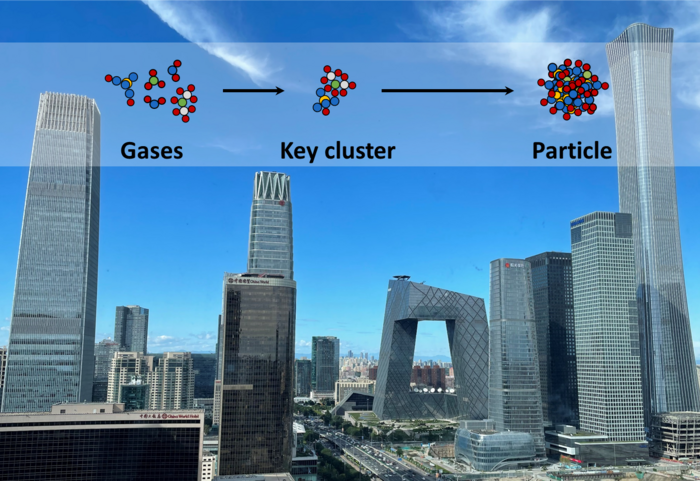An effective process for the formation of atmospheric ultrafine particles by the combination of gaseous sulfuric acid and bases has been reported by a combined research team led by Doctors Jingkun Jiang of Tsinghua University and Markku Kulmala of the University of Helsinki.
 On sunny days in megacities such as Beijing, gaseous acid and base pollutants form a large amount of new ultrafine particles. The clustering between one acid and one base is the rate-limiting step for new particle formation. Image Credit: Science China Press
On sunny days in megacities such as Beijing, gaseous acid and base pollutants form a large amount of new ultrafine particles. The clustering between one acid and one base is the rate-limiting step for new particle formation. Image Credit: Science China Press
The research explains the quick creation of secondary ultrafine particles, which could significantly affect climate and air quality.
Researchers discovered that creating hidden acid-base heterodimers is the primary process by which gaseous precursors overcome surface tension and produce ultrafine particles. This undiscovered mechanism explains the high particle generation rate in Chinese megacities.
National Science Review reported their findings.
There are hundreds of thousands of ultrafine particles in per cubic centimeter air in Chinese megacities, and a new particle formation event on a sunny noon can readily elevate their concentration by one order of magnitude within several hours.
Dr Jingkun Jiang, Tsinghua University
Jiang and Kulmala, along with Dr Runlong Cai, are committed to finding the essential mechanism for quick new particle creation to explain how new particles can be converted from gaseous precursors so effectively. They know that sulfuric acid is a vital precursor, but it can be challenging to select the right ones from a large pool of potential possibilities.
Urban air is a complex cocktail of chemicals with poorly understood interactions and feedbacks.
Dr Markku Kulmala, University of Helsinki
During the production of new particles in Beijing and Shanghai, the researchers saw extremely numerous sulfuric acid-containing molecular clusters. Sulfuric acid and amine molecules can be found in some of the observed clusters.
These offer compelling proof that amines play a role in the development of stable sulfuric acid clusters, which accelerates the process of converting sulfuric acid from gas to new particles.
It is intriguing that we measured fewer bases than acids in a cluster. There must be some key information hidden behind the measured signals.
Dr Runlong Cai, University of Helsinki
As there were no base molecules in the detected clusters containing one sulfuric acid molecule, it was previously hypothesized that the clustering between a base molecule and a sulfuric acid homodimer is the primary mechanism for new particle creation. But the study group discovered that this was a measuring artifact.
They discovered that the crucial mechanism is the production of hidden acid-base heterodimers by combining long-term data with theories based on quantum chemistry and cluster kinetics.
This mechanism ensures the quick synthesis of sulfuric acid clusters and new particles and is far more effective than the previously proposed mechanism using acid-acid homodimers.
The enigma of how new particles could routinely emerge in megacities despite a strong background particle loading is solved by hidden heterodimers. With a large portion of the detected sulfuric acid signals, the hidden acid-base heterodimers can successfully associate with one another.
As a result, even at low ambient amine concentrations, a high particle production rate close to the theoretical maximum is guaranteed. The temperature dependence of new particle creation in Beijing and Shanghai is similarly explained by the hidden heterodimers.
Cai added, “Atmospheric measurements are often perturbed by many factors. I did not expect such an amazing consistency between the measurements and the new theory.”
The researchers also used kinetic and thermodynamic analysis to look for the hidden base molecules. Strong amines, such as dimethylamine, are the main bases in acid-base heterodimers among the detected gaseous molecules, but ammonia and other weak bases, which are relatively prevalent, are more likely to be engaged in the subsequent cluster formation process.
Journal Reference:
Cai, R., et al. (2022) The missing base molecules in atmospheric acid-base nucleation. National Science Review. doi:10.1093/nsr/nwac137.